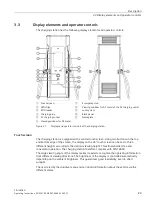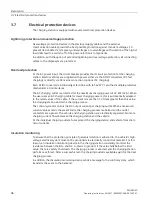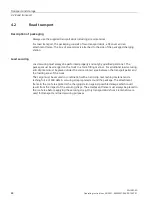
Description
3.7 Electrical protection devices
SICHARGE D
36
Operating Instructions, 02/2021, 8EM5907-0AA00-1AA7.01
3.7
Electrical protection devices
The charging station is equipped with several electrical protection devices.
Lightning protection and overvoltage protection
Overvoltage protection devices in the electrical supply cables and the external
communication cables provide the best possible protection against transient voltages. To
prevent device defects, temporary undervoltages or overvoltages with violation of the high or
low limits lead to a switch-off of the power-electronic components.
In addition, with the option of extended lightning and overvoltage protection, all connecting
cables to the dispensers are protected.
Overload protection
At the AC power input, the circuit breaker provides short-circuit protection for the charging
station. Electric vehicles are supplied with power either via the AC/DC converters (DC fast
charging) or directly via AC mains connection (optional AC charging).
Each AC/DC converter is intrinsically safe in line with IEC 62477-1 and has multiple protective
mechanisms at its interfaces.
The AC charging outlet is protected for the maximum charging power of 22 kW (32 A). When
the user uses an AC charging cable for lower charging powers, this is automatically adapted
to the rated values of the cable. If the current is more than 1.3 times greater than this value,
the charging station aborts the charging process.
The control system monitors the DC output current per charging outlet. When a measured
current value exceeds the preset limits, the charging process is aborted and the outlet
contactors are opened. The vehicle and charging station are electrically separated. No more
charging current flows between the charging station and the vehicle.
At the individual charging outlets, fuses protect the charging station and vehicle from short-
circuit currents.
Insulation monitoring
To ensure that the protection principle of galvanic isolation is adhered to, the vehicle's high-
voltage electrical system must not be grounded via electrically conductive material. For this
reason, an insulation monitoring device in the charging station constantly monitors the
resistance between the DC+ and DC- contacts to ground. If the value falls below the limit
value, there is a safety shutdown. The charging process is aborted, and the charging station
performs a self-test. After a successful test, the charging outlet is available again for the next
charging process.
In addition, the insulation monitoring device sends a message to the control system, which
transmits the event to the backend.
















































